
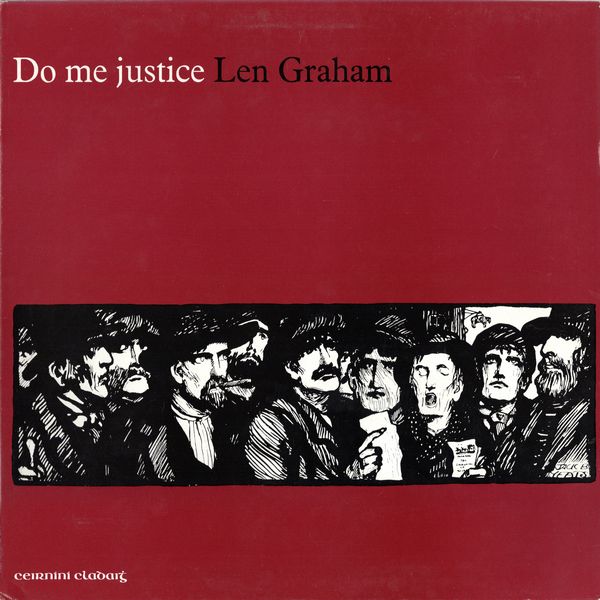
|
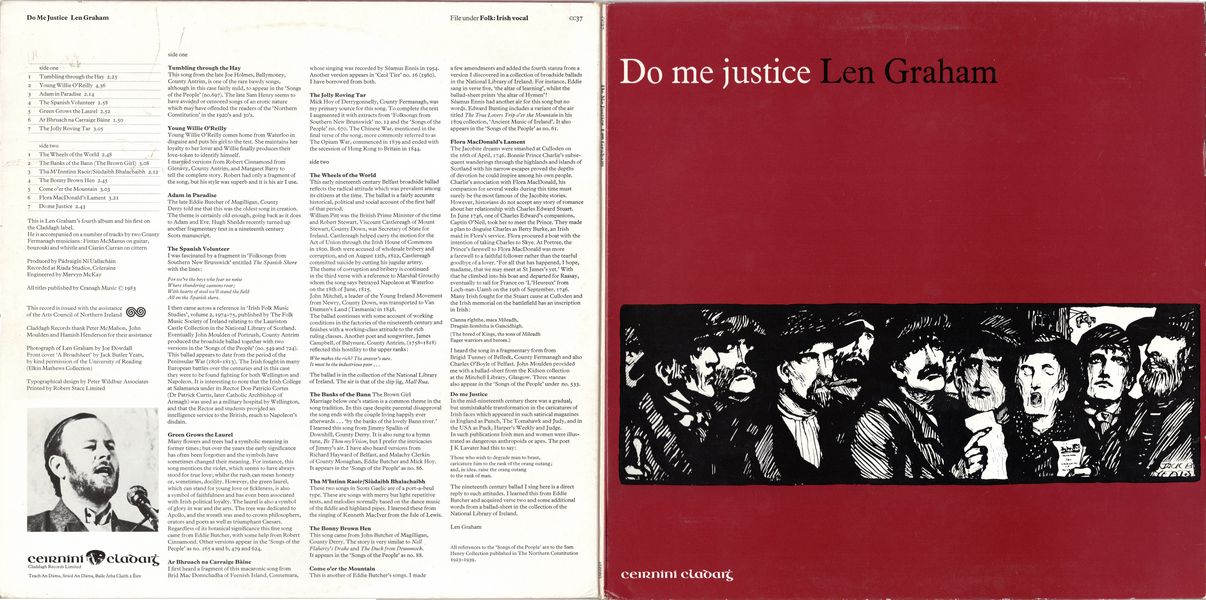
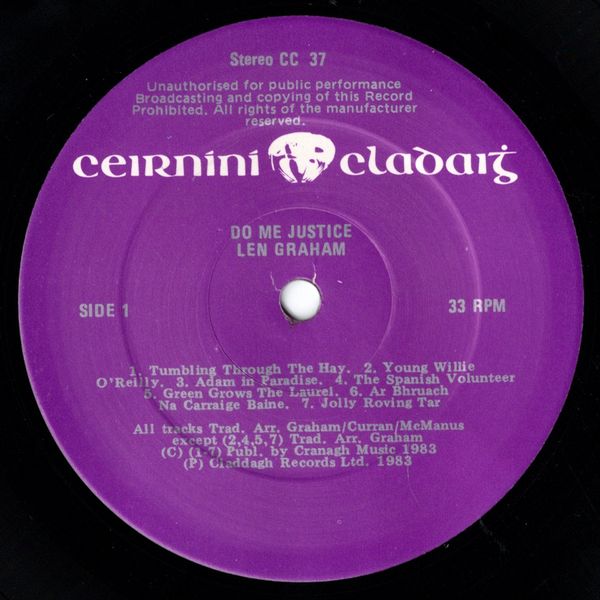
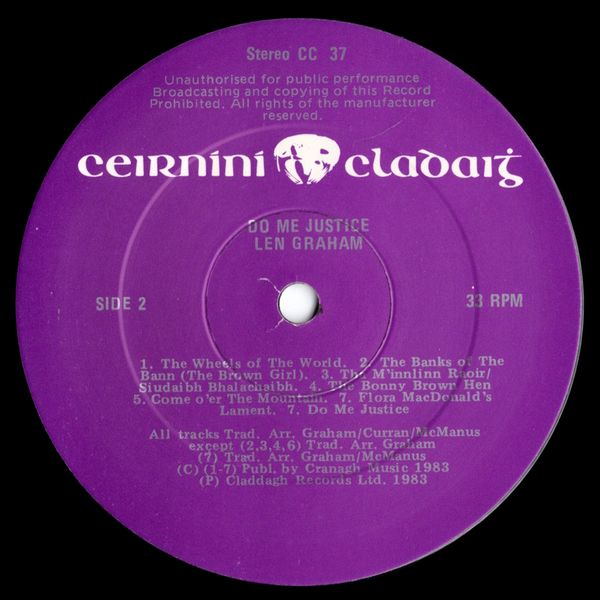
|
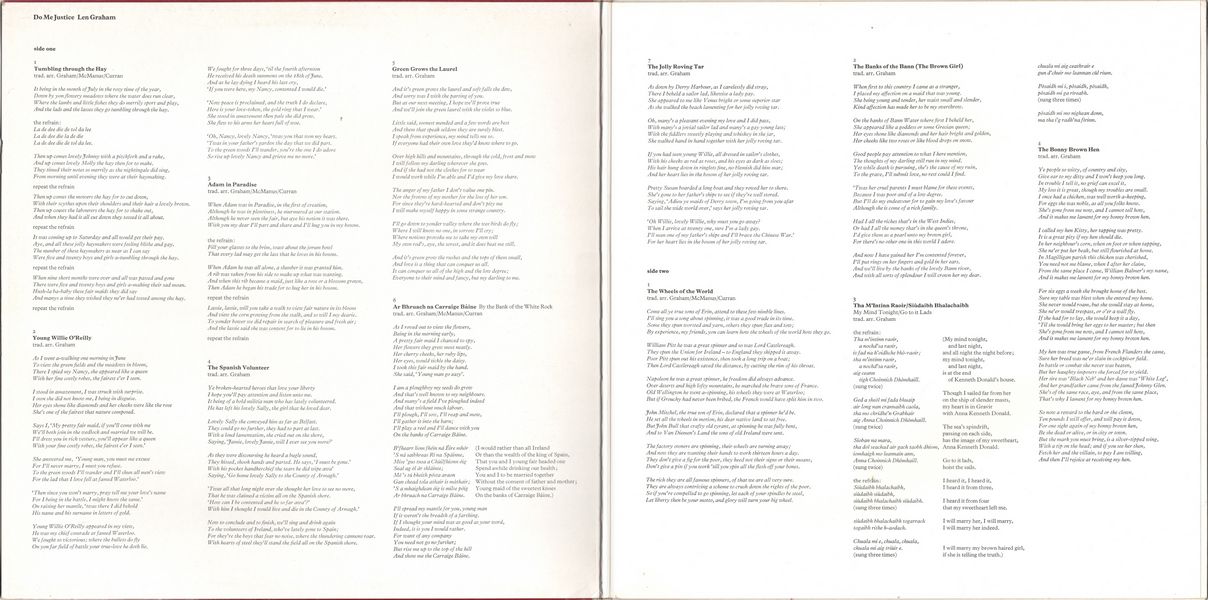
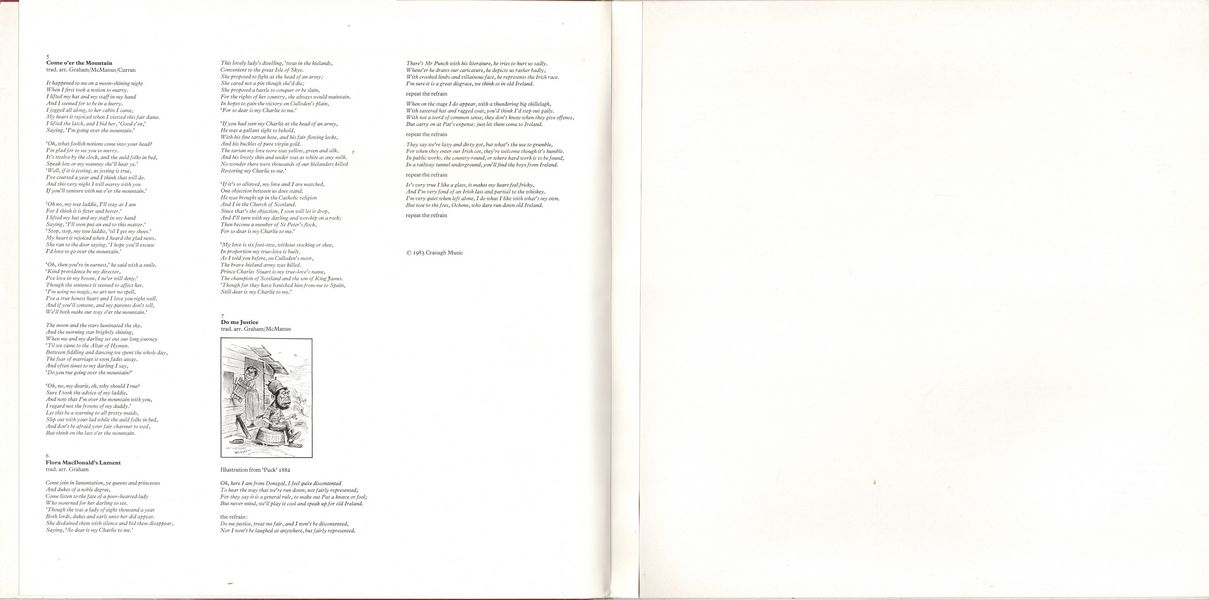
|
Sleeve Notes
Tumbling through the Hay — This song from the late Joe Holmes, Ballymoney, County Antrim, is one of the rare bawdy songs, although in this case fairly mild, to appear in the 'Songs of the People' (no. 697). The late Sam Henry seems to have avoided or censored songs of an erotic nature which may have offended the readers of the 'Northern Constitution' in the 1920's and 30's.
Young Willie O'Reilly — Young Willie O'Reilly comes home from Waterloo in disguise and puts his girl to the test. She maintains her loyalty to her lover and Willie finally produces their love-token to identify himself.
I married versions from Robert Cinnamond from Glenavy, County Antrim, and Margaret Barry to tell the complete story. Robert had only a fragment of the song, but his style was superb and it is his air I use.
Adam in Paradise — The late Eddie Butcher of Magilligan, County Derry told me that this was the oldest song in creation. The theme is certainly old enough, going back as it does to Adam and Eve. Hugh Sheilds recently turned up another fragmentary text in a nineteenth century Scots manuscript.
The Spanish Volunteer — I was fascinated by a fragment in 'Folksongs from Southern New Brunswick' entitled The Spanish Shore with the lines:
For we're the boys who fear no noise
Where thundering cannons roar;
With hearts of steel we'll stand the field
All on the Spanish shore.
I then came across a reference in 'Irish Folk Music Studies', volume 2,1974-75, published by The Folk Music Society of Ireland relating to the Lauriston Castle Collection in the National Library of Scotland. Eventually John Moulden of Portrush, County Antrim produced the broadside ballad together with two versions in the 'Songs of the People' (no. 549 and 724). This ballad appears to date from the period of the Peninsular War (1808-1813). The Irish fought in many European battles over the centuries and in this case they were to be found fighting for both Wellington and Napoleon. It is interesting to note that the Irish College at Salamanca under its Rector Don Patricio Cortes (Dr Patrick Curtis, later Catholic Archbishop of Armagh) was used as a military hospital by Wellington, and that the Rector and students provided an intelligence service to the British, much to Napoleon's disdain.
Green Grows the Laurel — Many flowers and trees had a symbolic meaning in former times; but over the years the early significance has often been forgotten and the symbols have sometimes changed their meaning. For instance, this song mentions the violet, which seems to have always stood for true love; whilst the rush can mean honesty or, sometimes, docility. However, the green laurel, which can stand for young love or fickleness, is also a symbol of faithfulness and has even been associated with Irish political loyalty. The laurel is also a symbol of glory in war and the arts. The tree was dedicated to Apollo, and the wreath was used to crown philosophers, orators and poets as well as triumphant Caesars. Regardless of its botanical significance this fine song came from Eddie Butcher, with some help from Robert Cinnamond. Other versions appear in the 'Songs of the People' as no. 165 a and b, 479 and 624.
Ar Bhruach na Carraige Báine — I first heard a fragment of this macaronic song from Bríd Mac Donnchadha of Feenish Island, Connemara, whose singing was recorded by Séamus Ennis in 1954. Another version appears in 'Ceol Tíre' no. 16 (1980). I have borrowed from both.
The Jolly Roving Tar — Mick Hoy of Derrygonnelly, County Fermanagh, was my primary source for this song. To complete the text I augmented it with extracts from 'Folksongs from Southern New Brunswick' no. 12 and the 'Songs of the People' no. 670. The Chinese War, mentioned in the final verse of the song, more commonly referred to as The Opium War, commenced in 1839 and ended with the secession of Hong Kong to Britain in 1844.
The Wheels of the World — This early nineteenth century Belfast broadside ballad reflects the radical attitude which was prevalent among its citizens at the time. The ballad is a fairly accurate historical, political and social account of the first half of that period.
William Pitt was the British Prime Minister of the time and Robert Stewart, Viscount Castlereagh of Mount Stewart, County Down, was Secretary of State for Ireland. Castlereagh helped carry the motion for the Act of Union through the Irish House of Commons in 1800. Both were accused of wholesale bribery and corruption, and on August 12th, 1822, Castlereagh committed suicide by cutting his jugular artery.
The theme of corruption and bribery is continued in the third verse with a reference to Marshal Grouchy whom the song says betrayed Napoleon at Waterloo on the 18th of June, 1815.
John Mitchel, a leader of the Young Ireland Movement from Newry, County Down, was transported to Van Diemen's Land (Tasmania) in 1848.
The ballad continues with some account of working conditions in the factories of the nineteenth century and finishes with a working-class attitude to the rich ruling classes. Another poet and songwriter, James Campbell, of Balynure, County Antrim, (1758-1818) reflected this hostility to the upper ranks:
Who makes the rich? The answer's sure.
It must be the industrious poor …
The ballad is in the collection of the National Library of Ireland. The air is that of the slip jig, Mall Rua.
The Banks of the Bann The Brown Girl — Marriage below one's station is a common theme in the song tradition. In this case despite parental disapproval the song ends with the couple living happily ever after-wards … 'by the banks of the lovely Bann river.' I learned this song from Jimmy Spallin of Downhill, County Derry. It is also sung to a hymn tune, Be Thou my Vision, but I prefer the intricacies of Jimmy's air. I have also heard versions from Richard Hayward of Belfast, and Malachy Clerkin of County Monaghan, Eddie Butcher and Mick Hoy. It appears in the 'Songs of the People' as no. 86.
Tha MTntinn Raoir & Siúdaibh Bhalachaibh — These two songs in Scots Gaelic are of a port-a-beul type. These are songs with merry but light repetitive texts, and melodies normally based on the dance music of the fiddle and highland pipes. I learned these from the singing of Kenneth MacIver from the Isle of Lewis.
The Bonny Brown Hen — This song came from John Butcher of Magilligan, County Derry. The story is very similar to Nell Flaherty's Drake and The Duck from Drummock. It appears in the 'Songs of the People' as no. 88.
Come o'er the Mountain — This is another of Eddie Butcher's songs. I made a few amendments and added the fourth stanza from a version I discovered in a collection of broadside ballads in the National Library of Ireland. For instance, Eddie sang in verse five, 'the altar of learning', whilst the ballad-sheet prints 'the altar of Hymen'!
Séamus Ennis had another air for this song but no words. Edward Bunting includes a variant of the air titled The True Lovers Trip o'er the Mountain in his 1809 collection, 'Ancient Music of Ireland'. It also appears in the 'Songs of the People' as no. 61.
Flora MacDonald's Lament — The Jacobite dreams were smashed at Culloden on the 16th of April, 1746. Bonnie Prince Charlie's subsequent wanderings through the highlands and islands of Scotland with his narrow escapes proved the depths of devotion he could inspire among his own people. Charlie's association with Flora MacDonald, his companion for several weeks during this time must surely be the most famous of the Jacobite stories. However, historians do not accept any story of romance about her relationship with Charles Edward Stuart. In June 1746, one of Charles Edward's companions, Captin O'Neil, took her to meet the Prince. They made a plan to disguise Charles as Betty Burke, an Irish maid in Flora's service. Flora procured a boat with the intention of taking Charles to Skye. At Portree, the Prince's farewell to Flora MacDonald was more a farewell to a faithful follower rather than the tearful goodbye of a lover. 'For all that has happened, I hope, madame, that we may meet at St James's yet.' With that he climbed into his boat and departed for Raasay, eventually to sail for France on 'L'Heureux' from Loch-nan-Uamh on the 19th of September, 1746. Many Irish fought for the Stuart cause at Culloden and the Irish memorial on the battlefield has an inscription in Irish:
Clanna ríghthe, maca Mileadh,
Dragain liomhtha is Gaiscidhigh.
(The breed of Kings, the sons of Mileadh Eager warriors and heroes.)
I heard the song in a fragmentary form from Brigid Tunney of Belleek, County Fermanagh and also Charles O'Boyle of Belfast. John Moulden provided me with a ballad-sheet from the Kidson collection at the Mitchell Library, Glasgow. Three stanzas also appear in the 'Songs of the People' under no. 533.
Do me Justice — In the mid-nineteenth century there was a gradual, but unmistakable transformation in the caricatures of Irish faces which appeared in such satirical magazines in England as Punch, The Tomahawk and Judy, and in the USA as Puck, Harper's Weekly and Judge. In such publications Irish men and women were illustrated as dangerous anthropoids or apes. The poet J K Lavater had this to say:
Those who wish to degrade man to beast,
caricature him to the rank of the orang outang;
and, in idea, raise the orang outang
to the rank of man.
The nineteenth century ballad I sing here is a direct reply to such attitudes. I learned this from Eddie Butcher and acquired verse two and some additional words from a ballad-sheet in the collection of the National Library of Ireland.
Len Graham
All references to the 'Songs of the People' are to the Sam Henry Collection published in The Northern Constitution 1923-1939.